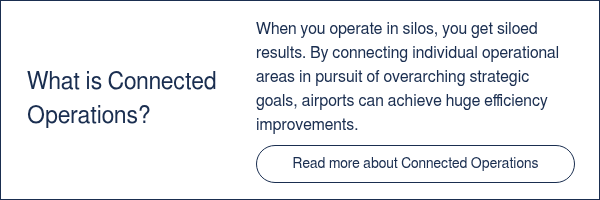Airports are responsible for the movement of millions of people and tons of cargo every year. This also means that they are responsible for keeping track of a wide range of data and information, from passenger management and baggage handling to gate assignments and aircraft parking positions.
An Airport Operational Database (AODB) is a centralized database system that allows airports to store, manage, and distribute real-time operational data crucial for their day-to-day activities.
For this reason, the Airport Operational Database is crucial to airport operations. The AODB works as a centralized database for real-time information. It integrates with airport control systems, resource allocation, and other essential systems, making it the core of airport operations.
In this article, we’ll cover the basics of what an AODB is used for and how it benefits your airport.
What is an AODB used for?
An Airport Operational Database is used to store, manage, and distribute data for a variety of essential functions related to airport operations.
The data which an AODB is used to store, manage, and distribute include information on:
- Flight management: An AODB is used to store and manage flight schedules, including arrivals, departures, changes, and delays. This information is crucial for communicating with passengers and airlines, as well as coordinating airport resources.
- Passenger information services: Via display systems, websites, and mobile apps, an AODB provides real-time flight information to passengers regarding flight status, gate assignments, and baggage claim information.
- Aircraft turnaround operations: An AODB supports the coordination of operations related to aircraft turnaround, including cleaning, catering, refueling, and maintenance. This helps to minimize turnaround time and maintain flight schedules.
- Operational reporting and analysis: An AODB generates operational reports and analyses for airport management to support strategic planning and continuous improvement efforts.
- Air Traffic Control (ATC) integration: With an AODB, you can exchange operational data with ATC systems in real time, which supports flight safety and efficiency.
- Security and emergency management: An AODB provides information — such as passenger and flight data — crucial for emergency screening, response operations, and ensuring the safety and security of the airport environment.
- Collaboration with airlines and service providers: An AODB is essential for facilitating information exchange between the airport and its partners, including airlines, ground handlers, and concessionaires. This enables the coordination of services and improves the overall passenger experience.
You might also be interested in: What is a Resource Management System (RMS)?
The benefits: How an Airport Operational Database enhances airport operations
The use of an Airport Operational Database brings numerous benefits to airport operations. By providing access to real-time data on information vital to airport operations, an AODB enables you to enhance efficiency, safety, and the overall passenger experience at your airport.
Here are six ways in which an AODB enhances airport operations:
1. Improved operational efficiency
An AODB enables you to centralize data management. This facilitates quick access to real-time information, which enables faster decision-making and more efficient resource allocation and utilization. In turn, this improves operational efficiency and leads to reduced turnaround times for aircraft.
2. Increased situational awareness
An AODB ensures a comprehensive overview of the operational environment and provides real-time data on flights, resources, and airport conditions. This enables airport operators and stakeholders to proactively manage operations and rapidly respond to any issues or emergencies that may arise.
3. Data-driven decision making
The wealth of information which an AODB provides can be analyzed for insights into operational trends, performance metrics, and areas with potential for improvement. Through this data-driven approach, the AODB supports strategic planning and initiatives for the continuous improvement of your airport operations.
4. Enhanced communication
With an AODB to store and distribute important data, it’s much easier to exchange information among your airport stakeholders, including airlines, ground handlers, ATC, and service providers. This enhanced communication enables you to better coordinate efforts and reduce the chances of misunderstandings or operational conflicts arising.
Connected Operations: Where does the AODB fit in?
While the AODB is indeed a key component in any airport operation management, it can not stand alone. It needs to be connected to all the airport data sources as well as other platforms that will create value from the AODB data through forecasting, optimization of resource planning, staffing, information sharing and reporting.
At Copenhagen Optimization, we call this “Connected Operations”: Bridging all data sources, systems and operational areas to ensure the highest possible airport efficiency. And we have created Better Airport, the world’s leading connected operations platform for airport operators, to bring clarity and confidence to plans, data, and complex decision-making.
You might also be interested in: Connected Operations – transforming Manchester Airports Group into a model of efficiency
In the figure below, we outline how the various airport systems and concepts fit together in a Better Airport context. The Better Airport platform consists of multiple modules for the planning and execution of airport operations, including modules traditionally thought to be part of an airport Resource Management System (RMS): Check-in planning, baggage reclaim planning and Stand/Gate planning.
In addition, it features modules not commonly found in airport planning solutions, including staff planning for security and border checkpoints, allocation of baggage make-up resources, passenger forecasting, task deployment and virtual queuing for passengers.
This unique list of modules makes Better Airport the only platform on the market to truly cover all planning aspects of an airport.

To achieve the goal of Connected Operations, Better Airport can easily be integrated with all relevant airport systems through the rich API. From the AODB, Better Airport receives real-time flight schedules update, immediately re-optimizes resource and staffing plans and returns the new allocations back to the AODB. The platform also benefits from integrations with systems supplying data on current passenger waiting times and boarding card scans at e-gates, while the optimized allocation plans may be forwarded directly to Flight Information Display Systems (FIDS) and Human Resource Management Systems (HRMS).
Enhance your airport operations with Copenhagen Optimization
To get the most value out of your data, your core operations can no longer be conducted in silos: they must be connected.
Better Airport utilizes all the data points that your airport has access to (including AODB), enabling your airport to get the most value out of the available data. This allows you to better manage your operations — from forecasting and planning to day-of-operation and real-time adjustments.
Learn more about 5 Airport Technology Trends to Watch in 2024





